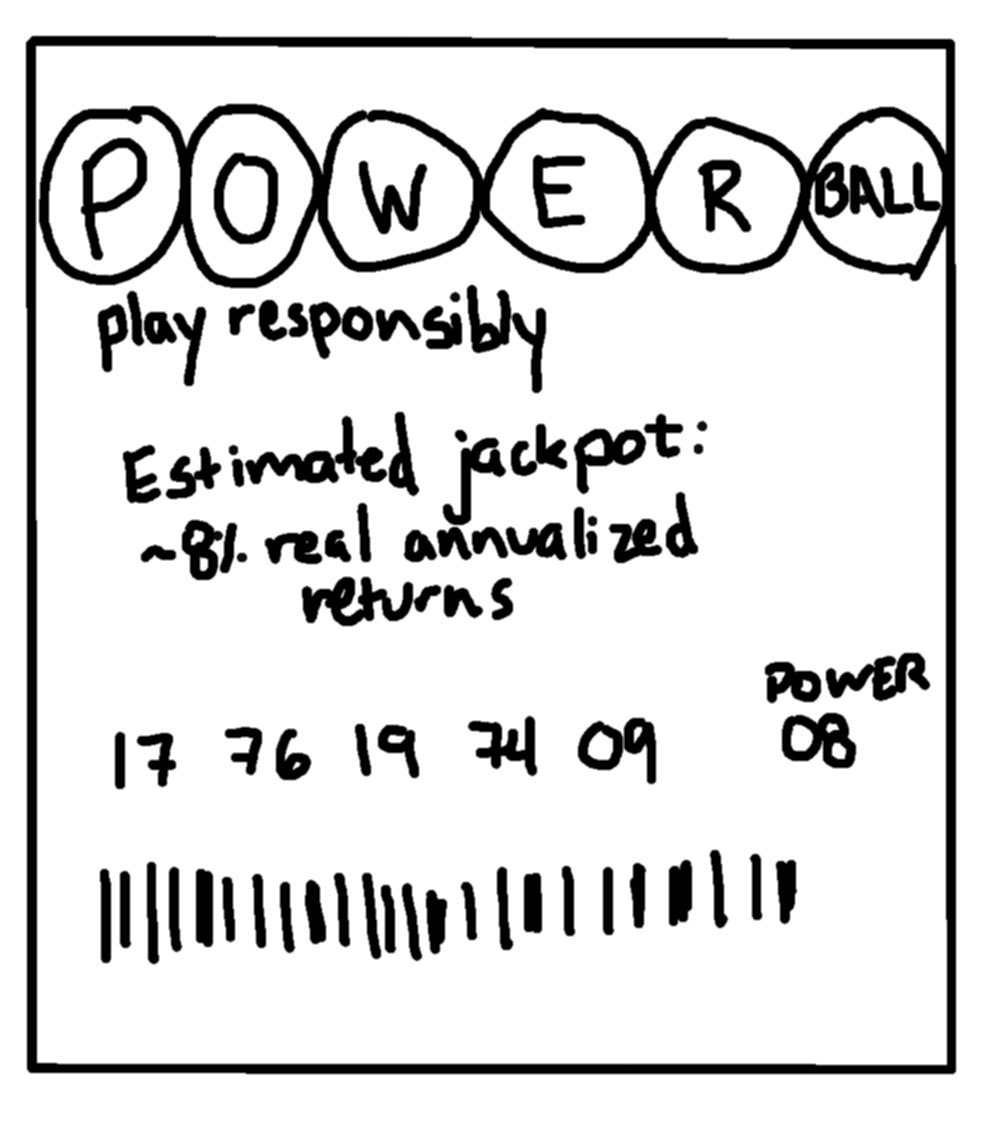Who Wants To Be A Millionaire?
The Gist: A tribute to the boring, brilliant, passive, and profitable index fund.
A review of multiple books, most notably index pioneer John Bogle’s The Little Book of Common Sense Investing.
For more specific commentary on capital allocation, check out my review Get Rich Slow.
I’ve come across a hot stock tip that could make you rich. I am writing now so you can take advantage of it ASAP.
It probably comes as close to easy money as you’ll ever come across. But you are going to need courage to see it through.
Billionaire Chuck Schwab has already apparently put most of his wealth into it. Legendary investors like Ben Graham and Warren Buffett have strongly endorsed it. Nobel Prize winning economist Paul Samuelson has called its creation the equivalent to the invention of the wheel! And JL Collins, author of the Simple Path to Wealth, even insists that acting on this means that “it is possible for every middle class wage earner to retire a millionaire.”This secret to beating the market? Don’t try. Which is not to say you should put all your money in cash (or even krugerrands) under your mattress. Instead, slowly, continuously buy, hold, and balance a diverse combination of low-cost index funds that return you the market average.
Figure 1. You’re aspiring to the type of investing that can be done from a hammock. Besides, those krugerrands can make your mattress lumpy.
But who could be satisfied with merely “average”? We’ll get into why “average” is a misleading term in a moment but let’s first consider how good a return this truly has been. Jack Bogle created the first true index in the 1970s through his firm Vanguard – I’ll be mentioning his excellent Little Book of Common Sense Investing as well as his devoted and grateful followers’ Bogleheads’ Guide to Investing throughout this review. The latter tells the story of Bogle receiving a letter in 2005 from a man who had been investing in Bogle’s first index since the disco era and was enjoying his portfolio of over $1,250,000. But what was truly remarkable was that, in his entire life, the investor had never earned more than $25,000 a year. Still, diligently, every month, he had put $600 – a third of his income – into an index and now reaped the benefit. And just so the comparison is clear: if he had simply saved that $600 a month in cash, he would only have had $216,000, one fifth of his actual total. If he had gone with gold, he might very well have lost money!
Figure 2. Despite the renewed popularity of “vintage” clothing, other “investments” of the 1970s have not turned out as well.
The true result was a virtuous combination of American capitalism’s long-term success, the investor’s discipline, and what Albert Einstein called the greatest mathematical discovery of all time: compound interest. Over the long run, the American stock market return – captured via index – has delivered generously, an average of over 8% a year from 1975 to 2020. This particular investor had the discipline to buy amidst stagflation and warnings of the death of stocks in the Carter years, and to keep buying (and holding) through recessions, stock market crashes, domestic financial crises, international financial crises, and bubbles bursting. And throughout that entire time, especially if he reinvested the dividends that stocks paid him, his original investment benefitted from the growth on growth – such that his original, first check of $600 gained, say, 10%, and then was $660, earning another 10% on the new total, so that over 30 years of repeating the phenomenon, that original $600 alone was worth over $10,000.
Figure 3. A close second for greatest mathematical discovery would have to be apple pi.
Of course, compound interest works for any return. Why invest in a passive index of nearly everything instead of carefully, studiously picking winners and avoiding losers? Surely, you think, you can do better than the average schmuck. The truth is you can. By investing in an index. The problem is that “average,” as it relates to the index’ returns, is misunderstood. One might think that half of investors do better than the index average. In fact, Collins cites a University of California study that “only about 1% of active traders” – not 50% – “outperform the market and that the more frequently they trade, the worse they do.” Amusingly, the Bogleheads even report on the investing outcomes of the Mensa Investment Club – “the exclusive society whose membership is restricted to persons scoring in the top 2 percent on IQ tests. During a 15-year period when the S&P 500 had average annual returns of 15.3 percent, the Mensa Investment Club’s performance averaged returns of only 2.5 percent.”
Figure 4. The eggheads have egg on their faces.
You probably also have a full time job, such that your day trading might better be characterized as night trading. And that job probably does not involve constant analysis of securities. (For context, Warren Buffett reads 500 pages a day). When you think you’ve found an under-valued stock, realize that you’re buying from someone who disagrees – and that someone is less likely to be another rando in his pajamas than a major investment group with gobs of money to spend trying to get an angle with the smartest analysts spending all their time using the fastest computers. Or as William Bernstein, author of the Four Pillars of Investing, puts it: you are “going up against the Sixth Fleet in a rowboat.” Bernstein suggests instead: “When you buy the market, you are hiring the aggregate judgement of the most brilliant and well-informed minds in finance.”
Perhaps you are humble enough to realize that you don’t have the Midas touch and that you as an individual can’t compete with the big guns – but if you can’t beat them, why not join them? Put your money in the Sixth Fleet – hire those best and smartest people to manage your money for you. Alas, the premise is flawed: you can beat them. With an index fund. Bogle cites the SPIVA study that found from 2001 to 2016 “an astonishing 90 percent of actively managed mutual funds underperformed their benchmark indexes.” Better than the record of individual active traders – but still abysmal! Is the secret, though, to just stick with those rare talents – that top 10% – that can beat the market?
Unfortunately, the top 10% of actively-managed funds are not the same over time. Bernstein reports that “literally dozens of studies” have verified that “past superior performance has almost no predictive value” over more than a year. For just a flavor, we can look at the ratings of Morningstar, the premier evaluator of mutual funds. Funds in the top 10% of performance get a five star rating. Mark Hulbert found in 2004 that “Over the past decade, Morningstar’s five-star equity funds have earned an average 5.7 percent against a 10.3 percent return for the Wilshire 5000.” Somewhat interestingly, since 1987 Morningstar itself has looked at the three most popular and least popular funds from a given year and followed them over the next three years: “Eight out of nine times, the unpopular funds beat the popular funds, and seven out of nine times the unpopular funds beat the average equity fund. Most tellingly, the popular fund categories also lagged the average equity fund seven of nine times.” Bogle reports, “According to a 2014 study by the Wall Street Journal, only 14 percent of five-star funds in 2004 still held that rating a decade later. Approximately 36 percent of those original five-star funds dropped one star, and the remaining 50 percent dropped to three or fewer stars.” The real results are actually even worse: young funds inherently get inflated ratings because they don’t have a long track record of comparison while older funds that failed have disappeared from lists. Bogle summarized the landscape in 2017:
281 of the equity funds that existed in 1970 are gone, mostly the poor performers. Another 29 remain despite having significantly underperformed the S&P 500 by more than one percentage point per year. Together, then, 310 funds—87 percent of the funds among those original 355—have, one way or another, failed to distinguish themselves. Another 35 funds provided returns within one percentage point, plus or minus, of the return of the S&P 500—market matchers, as it were. That leaves just 10 mutual funds—only one fund out of every 35—that outpaced the market by more than one percentage point per year.
Ultimately, Burton Malkiel, the author of the classic Random Walk Down Wall Street, observes “The few examples of consistently superior performance occur no more frequently than can be expected by chance.” Are you prepared to buy a lottery ticket that your choice of fund will be run by the next Warren Buffett? Or would you rather, as Bogle folksily advises, stop looking for the needle and buy the haystack?
Figure 5. Though perhaps that analogy is too tempting: Lottery tickets may be America’s most popular investment security. Time to start a Powerball index!
And yet, as if superior performance was not enough reason to invest in an index, there’s another significant appeal: costs. You cannot control how your investments will perform but you can be certain of what you pay intermediaries in expenses. As in the typical gold rush, the real winners all too often are not the miners but the suppliers. A typical actively-managed fund may have an expense ratio of 1 or 2% to pay for all those eggheads, corporate jets, computers, and pinstripe suits. The management fee may even slowly grow over time – between 1981 and 1997, as the market gained, the average fee jumped 50%. A total stock market index fund at a place like Vanguard, whose ownership structure is designed to keep fees low, has an expense ratio of 0.04%. So, for you to make money with an actively managed fund, they not only need to beat the market, a difficult enough task as it is, but they have to beat the market plus their fees. The Bogleheads helpfully explain:
“If you don’t think those miniscule costs matter, consider this: Let’s assume someone puts $10,000 in a mutual fund, leaves it there 20 years, and gets an average annual return of 10 percent. If the fund had an expense ratio of 1.5 percent, the fund is worth $49,725 at the end of 20 years. However if the fund had an expense ratio of 0.5 percent, it would be worth $60,858 at the end of 20 years. Just a 1 percent difference in expenses makes an 18 percent difference in returns when compounded over 20 years.”
Bogle offers more folksy advice: “In investing, you get what you don’t pay for.” Bernstein more clinically observes “The average investor receives a net return equal to the market’s minus expenses.” Bernstein goes further, however, in noting that the explicitly identified expense ratio does not capture the full costs of an actively managed fund. Because actively-managed funds are looking for vulnerabilities and more frequently trading in the market, they are paying commissions on transactions to brokers and they are paying more than someone sold it for because of spreads that go to market makers. You, as an individual day trader, would experience the same phenomenon. If an actively managed fund gets so popular that they are managing lots and lots of money, they also incur impact costs, where they can’t any longer buy discounted stocks on the cheap because they are so big and the opportunities are relatively small that they move the cost themselves. In contrast, a large index fund has very little turnover. Bogle continues his folksy streak: “Adding a fourth law to Sir Isaac Newton’s three laws of motion, the inimitable Warren Buffett puts the moral of his story this way: For investors as a whole, returns decrease as motion increases.”
We haven’t mentioned perhaps the biggest cost to your trading activity: Uncle Sam. To get back to Einstein, “Compound interest is the 8th wonder of the world. He who understands it, earns it; he who doesn’t, pays it.” The Bogleheads note that “Every time an active fund sells a profitable stock, it creates a taxable event that’s passed on to the investor.” The effect can be dramatic, as retold by Malkiel:
Taxes are a crucially important financial consideration, as two Stanford University economists, Joel Dickson and John Shoven, have shown. Utilizing a sample of sixty-two mutual funds with long-term records, they found that, pre-tax, $1 invested in 1962 would have grown to $21.89 in 1992. After paying taxes on income dividends and capital gains distributions, however, that same $1 invested in mutual funds by a high-income investor would have grown to only $9.87.
But there’s good news. Broad-based index funds are fairly tax efficient. What’s more, you can organize your investments in such a way to reduce the tax burden by funding vehicles like a 401(k) or Roth IRA. Yet that’s not the only organizing that will be useful to you. Hopefully by now you’re convinced of the benefits of index funds – but you are still going to need to make your most important decision: how much of your capital to allocate in which index funds. We’ll discuss your options in our next email.
Figure 6. Click here to buy American investing hero John Bogle’s Little Book of Common Sense Investing, which lives up to its title and is a stirring call to arms for investors to humble themselves by picking the indexes that outperform all the hard work of active managers. 8/10.
Figure 7. Click here to buy William Bernstein’s Four Pillars of Investing, 9/10. Incidentally, the four pillars that you must understand are the theory of investing, the history of markets, your own psychology, and the adverse interests of the investing business, which often charges you too much, among other dangers. Interestingly, Bernstein concedes “some evidence that the best securities analysts are able to successfully pick stocks” – but, alas – “in the aggregate, the benefits of stock research do not pay for its cost.” He recommends an annual meditation: “How do you avoid overconfidence? By telling yourself at least a few times per year, ‘The market is much smarter than I will ever be. There are millions of other investors who are much better equipped than I, all searching for the financial Fountain of Youth. My chances of being the first to find it are not that good. If I can’t beat the market, then the very best I can hope to do is to join it as cheaply and efficiently as possible.’”
Figure 8. Click here to buy the Bogleheads’ Guide to Investing, 9/10. A very practical and simple overview that goes deep into what it means to follow the path laid down by John Bogle.
Figure 9. Click here to buy Burton Malkiel’s classic A Random Walk Down Wall Street, 8/10. Though first published decades ago, Malkiel has continuously and freshly updated it to reflect the latest data and events
Thanks for reading! If you enjoyed this review, please sign up for my email in the box below and forward it to a friend: Think – do you know anyone with a 401K or Roth IRA? Anyone who likes money? Anyone who plans to retire?
I read over 100 non-fiction books a year (history, business, self-management) and share a review (and terrible cartoons) every couple weeks with my friends. Really, it’s all about how to be a better American and how America can be better. Look forward to having you on board!












